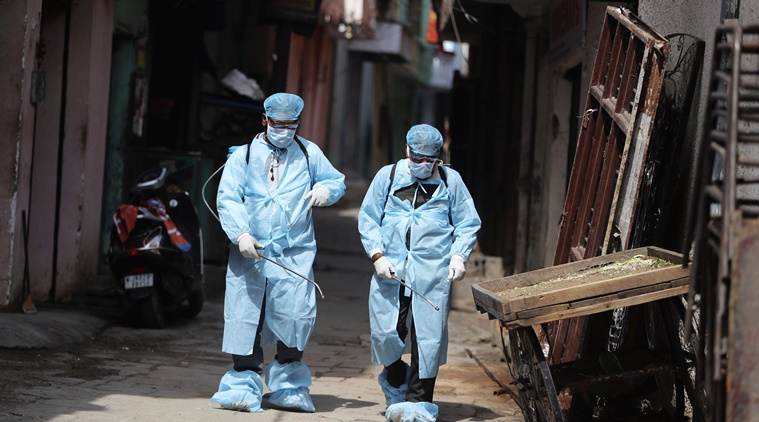 In Gujarat, the number of daily new cases fell outside the range on only five days in May. In June, daily case numbers in the state have found a new bracket — between 400 and 500 — and only on four days this month has the number of cases fallen outside this range. (File Photo)
In Gujarat, the number of daily new cases fell outside the range on only five days in May. In June, daily case numbers in the state have found a new bracket — between 400 and 500 — and only on four days this month has the number of cases fallen outside this range. (File Photo)
Since the third week of May, the growth of novel coronavirus infections in Gujarat has been crawling at less than 3 per cent — on Saturday, it was 2.35 per cent, the slowest in the country, along with Chandigarh, Andaman and Nicobar Islands, and Madhya Pradesh.
In Rajasthan, the growth rate of the infection is now 2.66 per cent, and in Madhya Pradesh, just 2.06 per cent.
Along with this remarkable slowing of the infection, these three states have also been reporting an unusual consistency in the number of new cases every day. For over a month now, these numbers have been largely confined to narrow ranges – between 300 and 400 in Gujarat, 200-300 in Rajasthan, and 150-250 in Madhya Pradesh — official data show.
In Gujarat, the number of daily new cases fell outside the range on only five days in May. In June, daily case numbers in the state have found a new bracket — between 400 and 500 — and only on four days this month has the number of cases fallen outside this range.
In Rajasthan in the last one month beginning May 13, the number of new cases has fallen outside the 200-300 range on only six days.
In Madhya Pradesh, the number of daily new cases has remained within the 150-250 range on all but five days since May 10.
Daily death numbers have been similarly consistent.
Thus, in 33 out of the 44 days since May 1, Rajasthan has reported between three and seven deaths every day.
Gujarat, which has the country’s second highest death numbers after Maharashtra, reported between 20 and 30 deaths on 32 of these 44 days.
And Madhya Pradesh has reported between five and 10 deaths on 20 out of the 30 days since May 13.
Nationally and in other states, these numbers show a greater randomness.
In India as a whole, the number of new cases usually remains within a small range for about 4-7 days before finding a new bracket. And in Maharashtra since May 1, daily new cases were in the 1,000-1,500 bracket on eight days, between 1,500 and 2,000 on five days, and between 2,000 and 2,500 cases on 13 days.
A limit on testing capacities could have been a possible explanation for this unusual uniformity. However, Rajasthan has increased its testing capacity rapidly — from 5,000-7,000 samples daily at the beginning of May to 13,000-14,000 now — and is testing numbers that are behind only after Tamil Nadu and Maharashtra.
Madhya Pradesh too, has increased its testing capacity from about 2,500 to about 6,000 samples a day; Gujarat’s testing has, however, remained constant between 2,500 and 6,000 samples daily through this period.
Rajasthan Additional Chief Secretary Rohit Kumar Singh said the uniformity in numbers could be due to the fact that these were state aggregates, and that there was much greater randomness at the “local” level.
“Most peaks that we encountered in the last 100-odd days have been episodic — a lane in Udaipur, a toll plaza in Pali, a small geography in Pratapnagar in Jodhpur, a small area in Jhalrapatan and Pokharan, a burst of migrants in Pali and Nagaur, etc. The problem with aggregating numbers over a day is that unless the local peak is really accentuated, it gets lost in the overall number. Had some episodes like that occurred simultaneously, we would seen sharp peaks and may be sharp troughs too,” he said.
Rajasthan, Singh said, has been very transparent in reporting death numbers. “Out of the 280 odd deaths, about 60 were brought dead to hospitals. (Many of) those deaths were due to suicide and accidents, etc. Still, we tested them, and if they turned out to be positive, we reported them as Covid deaths. Many other states are not doing it,” he said.
Asked about the consistency in daily case numbers in May, Gujarat Principal Secretary (Health) Jayanti Ravi said, “Positivity is a function of testing. We had basically saturated our testing capacity and had plateaued at around 3,000-3,800 per day (in May). Of course, we were also pool testing. We did see greater incidence (of Covid-19) in Ahmedabad, Surat and Vadodara in the initial days, an early peaking, but we have now seen a reduction in the inner city limits of Ahmedabad.”
Asked whether Gujarat’s sample positivity rate had been uniform for a month, Ravi said, “I am not sure we can say that because every district may not have been uniformly tested but small deviations in (testing) weightages (district-wise) may have cancelled each other out.”
An official spokesman for the Madhya Pradesh government said that the increase in testing means the positivity rate has declined, not remained constant. The death rate had increased recently, but has now come down, so that is not constant either.
“Better treatment is the explanation for decline in death rate. The deaths and positive cases are being reported from new areas. It is true that unlike other states, MP has not seen a surge in the unlock period,” the spokesman said.
(With Hamza Khan in Jaipur, Sohini Ghosh in Ahmedabad, and Milind Ghatwai in Bhopal)